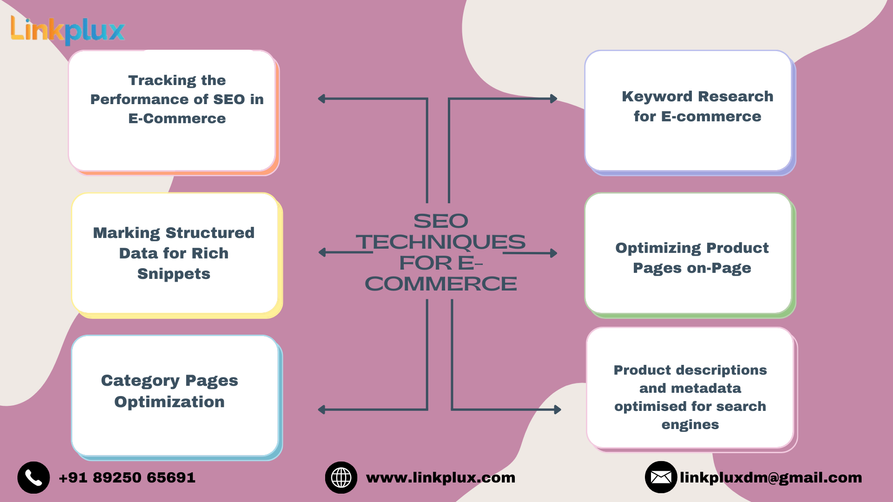In today's rapidly evolving e-commerce landscape, characterized by intense competition and shifting consumer preferences, establishing a robust SEO strategy is essential for achieving success. E-commerce SEO serves as the cornerstone of any thriving online retail venture, guiding organic traffic to your store and significantly improving conversion rates and revenue. This comprehensive guide explores effective strategies that e-commerce businesses can employ to bolster their SEO(search engine optimization) efforts and foster sustainable growth.
The Essential Role of E-commerce SEO
In conjunction with Digital Marketing, e-commerce SEO plays a pivotal role in the success of online retail ventures. Through meticulous website optimization for search engines, you can enhance visibility, attract qualified traffic, and ultimately drive sales. Given the vast array of products available online, strategic optimization techniques prioritizing user experience and relevance are crucial to stand out amidst competitors.
Keyword Research for E-commerce Success

Keyword research serves as the foundation of any successful SEO strategy. For e-commerce websites, identifying high-value keywords resonating with your products and target audience is imperative. Exhaustive keyword research uncovers relevant search terms, illuminates user intent, and enables optimization of product listings accordingly. Tools such as Google Keyword Planner, SEMrush, and Ahrefs facilitate the discovery of profitable keywords with substantial search volumes and minimal competition.
Critical On-Page Optimization
Optimizing product pages is vital for maximizing visibility and driving organic traffic. Each product page requires thorough optimization with relevant keywords seamlessly integrated into titles, headings, meta descriptions, and image alt tags. Additionally, ensure that product descriptions are informative, engaging, and distinctive, offering valuable insights to potential customers. Enhancing product images with descriptive filenames and alt text not only enhances accessibility but also improves search engine crawlability.
Crafting SEO-Friendly Product Descriptions and Metadata
Creating SEO-friendly product descriptions and metadata is pivotal for enhancing discoverability and driving conversions. Focus on crafting compelling, keyword-rich product descriptions highlighting key features, benefits, and unique selling points. Integrate relevant keywords naturally within the content while maintaining readability and coherence. Additionally, optimize meta titles and descriptions to attract clicks and improve click-through rates (CTR) in search engine results pages (SERPs).
Optimizing Category Pages for Enhanced User Experience
Optimizing category pages is instrumental in refining website navigation and enhancing user experience. Ensure meticulous structuring, organization, and optimization of category pages with relevant keywords. Utilize clear and descriptive headings, subheadings, and navigation menus to facilitate seamless browsing for users and search engine crawlers alike. Furthermore, integrate unique and informative category descriptions providing context and guidance to visitors.
Leveraging Structured Data Markup for Enhanced Visibility
Utilizing structured data markup empowers e-commerce websites to enhance Search Engine Optimization listings with rich snippets, such as product ratings, prices, availability, and more. By adhering to Google's schema markup guidelines, you can elevate your product listings in SERPs, increasing visibility and enticing more clicks. Rich snippets not only enhance the visual appeal of search results but also provide valuable information to users, influencing their purchasing decisions.

Prioritizing Backlink Building for Enhanced SEO
Acquiring high-quality backlinks is essential for strengthening domain authority, credibility, and search engine optimization rankings. Focus on obtaining authoritative and relevant backlinks from reputable websites within your niche. Employ strategies like guest blogging, influencer outreach, and content marketing to naturally earn backlinks. Additionally, ensure that your e-commerce website is featured on relevant directories, review sites, and industry-specific platforms to enhance online visibility and attract referral traffic.
Implementing Technical SEO for Optimal Performance
Adhering to technical SEO best practices is crucial to ensuring that your e-commerce website is optimized for search engine crawlers and provides an optimal user experience. Conduct regular site audits to identify and rectify issues such as broken links, duplicate content, page speed deficiencies, and mobile responsiveness. Optimize website architecture, URL structure, and internal linking to amplify crawlability and indexation. Furthermore, integrate HTTPS encryption, optimize robots.txt, and generate XML sitemaps to enhance website security and accessibility.
Harnessing Content Marketing to Drive Traffic and Engagement
Content marketing plays a pivotal role in driving traffic, engagement, and conversions for e-commerce websites. Develop a comprehensive content strategy comprising blog posts, product guides, tutorials, and videos tailored to address user needs and interests. Create valuable and informative content resonating with your target audience, encouraging social sharing and backlinking. Additionally, leverage user-generated content, customer reviews, and testimonials to build trust and credibility among potential buyers.
Monitoring and Analyzing E-commerce SEO Performance
Regular monitoring and analysis of e-commerce SEO performance are essential for identifying areas of improvement and optimizing your strategy for maximum effectiveness. Utilize analytics tools such as Google Analytics, Google Search Console, and third-party SEO platforms to track key metrics such as organic traffic, keyword rankings, conversion rates, and revenue generated. Evaluate the performance of individual product pages and categories, identify top-performing keywords, and refine your SEO strategy accordingly to ensure continuous growth and success.
In conclusion, e-commerce SEO is a multifaceted endeavor requiring careful planning, execution, and ongoing optimization. By embracing the strategies outlined in this guide, e-commerce enterprises can enhance their online visibility, attract qualified traffic, and ultimately drive conversions and revenue. Stay abreast of industry trends, algorithmic updates, and best practices to stay ahead of the competition and achieve sustainable growth in the constantly evolving digital landscape.























